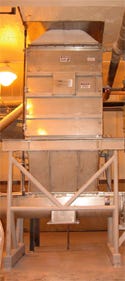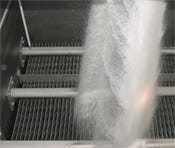February 27, 2008
Annual worldwide salt production has increased over the past century from 10 million to more than 200 million tons. Today, nearly 100 nations have salt-producing facilities, ranging from primitive solar evaporation to advanced multistage evaporation in salt refineries. Salt is produced for use as table salt in homes or such commercial establishments as restaurants. Salt is also used for other applications, such as water softeners, manufacturing, agriculture, swimming pools, meat cures, or the highway industry.
|
The Bulkflow heat exchanger from Bulkflow Technologies Inc. in a salt production facility |
The United States produces about 25% of the world’s salt—some 46 million tons a year. The second-largest producer is China, followed by Germany, India, Canada, Australia, Mexico, France, Brazil, and the UK.
Salt is mined using several methods. Dry salt, for example, is produced using three basic technologies: solar evaporation of seawater or saline lake water, solution mining, or conventional deep-shaft (rock salt) mining. In the United States, nearly half of the salt produced is in the form of brines from captive brine wells to supply chloralkali to chemical companies.
Bulkflow Technologies Inc. has been approached by several producers and marketers of salt products about how its heat exchanger could be used to more uniformly cool salt leaving a drying operation, or to more uniformly warm the salt for stronger pellets.
This article describes a solution-mining facility that installed a Bulkflow heat exchanger a little over a year ago to produce table salt. Besides salt, the Bulkflow heat exchanger has been successfully applied to chemicals, fertilizers, polymers, detergents, catalysts, minerals, oilseeds, grains, food products, sugar, and biosolids.
Solution Mining System
Typical of many solution mining operations, in the operation being described, saturated brine is boiled under partial vacuum with steam in enclosed vessels called vacuum pans. The brine is mined from underground rock salt (halite) and then fed to vacuum pans where the salt crystallizes.
After it is crystallized, the salt is continuously dried on rotary filters. Gas burners heat the air that passes through the cake of moist salt on the filter screen. A blade shaves the salt off of the filter. The salt is then sent through a drying process where its temperature is monitored to ensure all the moisture evaporates. The salt leaves the drying operation still hot.
Previously, this facility used an open, cascading-type aspirator that reduced the salt’s temperature with ambient cooling air. An increase in production throughput using this system was not practical since the dust collection system was fully loaded, and space limitations restricted expansion with a larger aspirator. The solution was to find a more compact system that could operate within a limited space.
According to Andy Nix, sales engineer for Bulkflow Technologies Inc., the table salt producer knew of a Bulkflow heat exchanger being used by a nearby competitor.
“The Bulkflow system had been in operation several years, was effective, and was trouble-free,” Nix said. “Based on feedback the company received, it was felt that the Bulkflow system was the perfect solution.”
Bulkflow Heat Exchanger Installed
To meet the requirements of the U.S. table salt producer, Bulkflow customized a system that was compact, met existing space requirements, and used existing infrastructure. Since the plant used wet scrubbers for dust collection, plenty of water was already available and had to be rerouted to the cooler only. No additional energy was required. This made the system attractive to the salt producer.
Bulkflow engineers specified a mass-flow screw feeder to control the discharge rate through the cooler and maintain a uniform cross-sectional velocity as the salt flowed through the system.
According to Nix, the Bulkflow system’s mass-flow discharge device was critical, since it ensures constant and consistent cooling of the salt as well as reliable flow downstream to the packaging facility. To deliver the system, the heat exchanger had to be shipped in two sections: the top or plate bank and the bottom or transfer hopper. Shipment in sections was necessary because of space restrictions during delivery and installation. For example, the unit had to be installed in an area with only 10 ft of headroom.
Product Flow
|
A U.S. table salt producer uses a heat exchanger to cool iodized salt to a consistent temperature of 150°F at rates of up to 35 tn/hr. The entire cooling process takes 3–4 minutes. |
Salt enters the heat exchanger at a temperature of more than 200°F at a rate of up to 35 tn/hr. Equipment is contained in a totally sealed unit to prevent any dirt or contamination from entering the system. Depending on the inbound salt temperature, the system has to cool the salt by 15–25% to prevent sticking and discoloring. The cooling takes place within minutes inside the Bulkflow system. The desired cooling temperature is typically between 150° and 170°F.
Cooling the table salt down to this temperature is necessary in order to spray the salt with an iodine solution. The iodine solution must be applied to the salt at a temperature less than 170°F to prevent the solution and flow-enhancing additives from caramelizing or discoloring.
The heat exchanger consists of several hollow, fully welded, water-cooled, closely spaced stainless-steel plates. Salt passes slowly by gravity in mass flow between the vertical heat transfer surfaces formed by the welded plates in 3–4 minutes. Cooling water circulates between the plate’s dimples and cools the salt to the desired cooling temperature.
For even cooling, the salt moves at a uniform rate over the cooler. A discharge feeder regulates the product flow, quality, and temperature. Adjusting the speed to the screw feeder regulates the flow rate. After additives are mixed in, the salt moves to the packaging facility.
“The Bulkflow system is totally enclosed to provide better control for a food-grade product versus the previously used system, which was open and vulnerable to contamination,” noted Nix. “A consistent cooling temperature is being maintained and has resulted in a 50% increase in product flow for enhanced productivity. Maintenance costs have been minimal and operating costs low.”
The Benefits of Heat Exchange
The Bulkflow heat exchanger is a sophisticated combination of the two sciences of indirect heat transfer and the mass flow of bulk solids. Heat exchanger technology offers numerous benefits over traditional fluid-bed or rotary-drum cooling methods that were also considered by the table salt manufacturer. Unlike many other types of bulk-solids coolers, the Bulkflow system does not require large volumes of air to operate and instead lets gravity do the work to greatly reduce energy consumption. Other benefits include zero emissions, lower installed capital cost, modular construction for easy expansion, and a compact design that fits into tight areas.
Since installing the Bulkflow system, the table salt manufacturer has had a consistent cooling temperature and a 50% increase in product flow for enhanced productivity. The manufacturer was able to install the system within the limited space requirements and used much of the infrastructure already in place for savings in capital cost.
For more information on the Bulkflow heat exchanger for salt or other applications, contact Bulkflow Technologies Inc., Calgary, AB, Canada, at 866-379-3500, [email protected], or www.bulkflow.com.
You May Also Like




